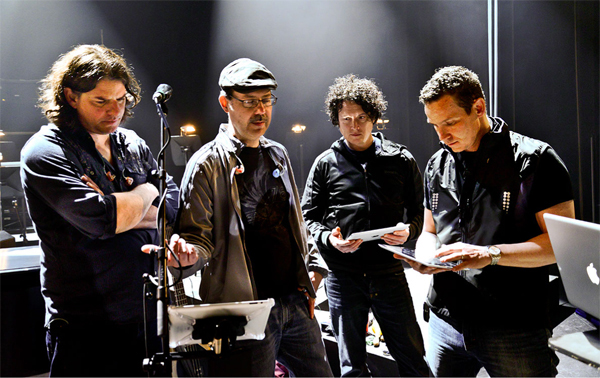
Communicating Needs
“He hadn’t even heard it yet,” Knesel recalls, “and then he told me how he had been hanging out with his band talking about getting such a device not long before our meeting. If ever I was in the right place at the right time, this was it.”
That night Adamson was enlisted as the band’s first “test mule” for the system. Gaining valuable feedback from him after the show, Knesel developed the system further and set a date for the band to try a full-on test the next time they were in Pennsylvania. This next test proved to be a success, and at that point it was agreed that the band would implement it.
“But this was the last gig of an American leg of the tour,” Knesel adds, “and they were going to be off for a few months. We decided that rather than do something crazy like try to assemble a system and shove them out the door to do their next one-off gig in South America, we’d meet them at the Ruth Eckerd Hall in Clearwater, Florida, in March of this year when they came back to resume the North American tour. That would give us all time to communicate our needs back-and-forth and really fine-tune the full system.”
As conceived by Pivitec and the Hodgson team, the band’s new personal monitoring system receives analog input from Heckers’ DiGiCo console, with signals arriving at a pair of e16i 16-channel input modules, which Ethernet-connect to a e9sw-p switch.
A 9-port managed GbE switch supporting PoE, the e9sw-p makes all of the system’s network connections. A sum total of six of e32 32-channel mixers plug-in here, as does a wi-fi base station that interfaces with the system’s iPads for control.
As a result, the band was able to ditch an entire flight case of old gear. In its place, four channels of Sennheiser wireless mic systems and another four channels of wireless Sennheiser IEM systems all drop into a 5-space rack that also houses all of the wireless antenna combiners, receivers for the mics, transmitters for the IEMs, antenna combiners, and power supplies. In turn, this entire package fits into a Pelican case.
Ready To Travel
The Pivitec system follows a similar plan, once again easily packing itself into a 5-space rack that slips into a Pelican case. Both cases tip the scales at less than 70 pounds and have been confidently checked as baggage on flights around the world since the system was commissioned in March.

Three of the e32 mixers are rack-mounted. Two more are hardwired onstage for drummer Bryan Head and bassist David Carpenter. The sixth e32 provided with the rig is officially designated as a spare, but sees regular use under the guidance of stage tech Wim Daans, who uses it to keep tabs on the network audio that’s traveling to each of the musicians.
Each e32 has a high-output headphone amp built to work in loud environments. Stereo line outputs are provided for driving other devices like wireless IEMs, power amps, or powered loudspeakers.
Digital-to-analog conversion (24-bit/48 kHz) is onboard, and the built-in DSP offers three bands of EQ on each channel as well as a stereo 3-band EQ and limiter on the master outputs.

